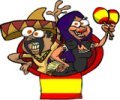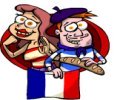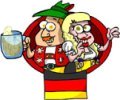|
Verb ConjugationVerb conjugation is the process of taking a verb and adding different endings for words like I, you, he, she, it, we, and they (pronouns). In English we say: I talk, you talk, we talk and they talk.But we say:
This business of changing the endings for some pronouns is called conjugating a verb, or conjugation of verbs. Verb conjugation in English is relatively easy compared to most European languages. If we put the above conjugations in a table this is how it looks in a "standard" format. The verb table below is one of the most commonly used layouts that language textbooks use when teaching verbs.
Note we have included the word 'you (all)' because many languages, including many European languages like Spanish, German, French, Italian all have a unique conjugation for this pronoun, which is 'you' when there is more than one of you. This is the pattern that most conjugation tables or charts use in most language texts or verb texts. Rows in the Verb Conjugation TablesLet's look more closely at the tables of conjugated verbs.Notice in ROW 1 we have I and WE. If we have a group and start counting from ourselves, I would be number 'one'. So 'I' is referred to as the first person. Likewise if we had a few groups of people, and we were to count the groups, starting with our own group, we would be the first group. So like 'I', 'we' is also considered to be the first person or 'in the first person' is common terminology with conjugation. So the first person is ROW 1. Continuing our counting, you and you all are considered the second person... and ... Columns in the Conjugated Verb TablesOn the left side, in the first column notice that all the pronouns refer to one person, so they are considered singular.The second column, we, you all, they refer to more than one person, so they are plural. So if we add these names to the verb conjugation tables, this will show it more clearly.
Conjugation is a matter of changing the verb endings for each pronounSo to now conjugate a verb, it is a matter of taking the infinitive of the verb (its pure form) and changing the endings.For example the infinitive in English of the verb 'talk' is 'to talk'. The infinitive of 'talk' is 'to talk'. In Spanish the infinitive of to talk is HABLAR. So to conjugate the verb, we drop the last two letters 'AR' and are left with a stem - HABL- We then just add the following endings to the verb stem.
So this is how the verb table for the verb hablar would look.
French Verb ConjugationIn French the infinitive of to talk is parler.The French drop the ending, the last two letters '-ER', to have a stem of PARL- and add endings as follows.
So this is how the verb table for the French verb parler would look.
Then this process continues with all the other verb tenses and moods. The trick to conjugating verbsThe main thing to learn about conjugating verbs is to learn the different patterns, starting with the regular patterns, that occur most frequently. Soon you'll know the conjugation patterns for the various verb tenses,and when you learn a new verb, you'll be able to simply add the verb endings to conjugate any new verb.The exceltra team has a verb learning course with cartoon Memory Triggers to help you remember these patterns, each tense and pattern being given, in true-exceltra 200 Words a Day! style, a CARTOON CHARACTER to help you remember your verb conjugation patterns. Each character is called a TENSE CHARACTER!. Learning ALL the Verb Conjugations in ALL the tensesWe recommend that when you learning verbs in a foreign language, that you are best to do it in a verb table that covers ALL the conjugations, present, past, future, conditional, subjunctive, simple and compound. We have hundreds of such examples:Using these verb tables you should read and recite the verb going:
Get instant notification to your PC of new material on this website...For instant notification of new pages and updates to this site, click on the RSS button in the yellow box at the top left of this webpage and follow the simple instructions, and your computer will be sent an instant signal the minute any new material appears on this site.200 Words a Day Language Learning Home Page | Learn Spanish Verb Conjugation and Verb Tenses | Learning French Verbs | Learning German Verbs | Learning Welsh Verbs | Learning Italian Verbs 200 Words a Day! Excelerated Language Learning Software - Accelerated verb learning the excelerated learning way - made easy Transcity Properties Ltd, 32 Alverton, Great Linford, Milton Keynes, Buckinghamshire, MK14 5EF, United Kingdom. Serving excelerated accelerated learning to the world.© 2007-2012 Verb Conjugation |
|||||||||||||||||||||||||||||||||||||||||||||||||||||||||||||||||||||
IMAGINE how you'd
FEEL
seeing yourself learning at a rate of 200 words a day ... the ideal companion course that complements any language course.
|









